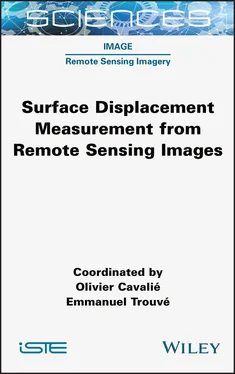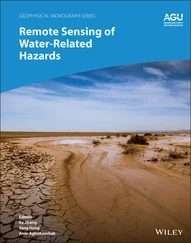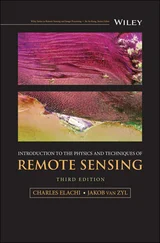Agile satellites: The agility of satellites is a key function. Agile satellites are able to do attitude maneuvers and focus on one scene. This increases the revisit frequency over the same region, and so reduces the time interval between two acquisitions. Such satellites are able to point towards a geographical point thanks to steering mirrors or by changing their whole attitude (yaw, pitch and roll control).
Base-to-height (B/H) ratio: The shift between two images creates a stereoscopic parallax in one direction (see Chapter 2). The stereoscopic angle (also called the base-to-height or B/H ratio) is the ratio between:
– the distance between the two viewing points (base – B);
– and the distance to the observed scene (height – H).
In the older generation of satellites, the B/H ratio was directly fixed with the instrument characteristics. For example, the SPOT-5 satellite had high-resolution HRS instruments to provide large-area along-track stereoscopic images (forward and backward of the satellite). With agile satellites, it is possible to choose the best view conditions and define the choice of B/H ratio. A large B/H ratio favors the observation of different points of view of the scene (e.g. two faces of buildings) but creates constraints on the disparity computation, as some elements of one scene are not seen in the other one. With a lower B/H ratio, the delay between two images is reduced and a scene can be observed under nearly the same conditions, but it adds constraints to the precision of the disparity computation algorithms. In the case of SPOT-5, the shift between panchromatic and XS detectors (19.5 mm in the focal plane) creates a slight stereoscopic angle that allows a stereo reconstruction using the P+XS correlation. In the case of Pléiades, the B/H ratio is chosen by the user.
The key optical parameters of satellite systems are explained in the following:
Spatial resolution: Spatial resolution is a measure of the smallest angular or linear separation between two objects or two pixels on the ground. It is usually expressed in radians or meters. Spatial resolution decreases as the viewing angle increases. Spatial resolutions are, in general, given at the nadir of the satellite. For example, for Ikonos, the spatial resolution is equal to 0.82 m at the nadir and 1 m at 26 °off-nadir.
Table 1.4. Examples of satellite missions and B/H ratios
| Satellite |
Mission characteristics |
B/H ratio |
| SPOT-5 |
Steering mirror (MCV). Stereoscopic angle up to 54 deg |
1.02 |
| SPOT-5 |
HRS instrument: angle 40 deg, delay 90 s |
0.8 |
| Co3D |
Synchronous acquisitions |
0.20–0.30 |
| SPOT-5 |
PAN–XS stereoscopic angle: delay 2.25 s |
0.018 |
| Pléiades |
Satellite agility – stereo or tri-stereo |
0.10–0.20 |
| WorldView-3 |
Satellite agility – stereo or tri-stereo |
B/H = 0.20–0.40 |
Spectral resolution or spectral bands: A ground feature or target is defined by its reflectance and spectral emissivity curve. Its response depends on the wavelength ranges. Different classes of objects in an image can thus be distinguished by comparing their responses over distinct wavelength ranges. A large spectral band captures more signal energy and thus enhances the SNR of the image. A panchromatic band defines a wide spectral band, with high SNR and high resolution. In contrast, a multispectral band (XS) captures specific wavelength ranges separated by filters or instruments sensitive to particular wavelengths: the received signal energy decreases as the bandwidth decreases, and therefore the satellite system is designed with a lower resolution to maintain an acceptable SNR. For a given satellite system, regardless of the spectral bands, disparity estimations are performed with the bands that have the highest spatial resolution and the best SNR. Spectral bands may be separated into several families or groups: thermal infrared (TIR) and medium-wavelength infrared (MWIR) depend not only on solar illumination but also on emission from the imaged objects themselves.
Swath: Swath is the geographical width of the image, which is linked to the optical instrument and the number of detectors in the sensor.
Viewing angle/incidence angle: The viewing angle (satellite point of view) is the angle between the nadir point and the angle towards the terrestrial point. The incidence angle (region point of view) is the angle between the vertical to a point and the direction of the satellite. Thanks to steering mirrors or the agility of the whole satellite, it is possible to modify acquisition angle configurations. A low incidence angle (region near the satellite nadir) means that, for example, only roofs can be seen. With a high incidence angle, building facades can be seen, but some occlusion occurs (hidden faces, hidden streets, etc.). Spatial resolution decreases as the viewing angle increases. Hence, spatial resolutions are given at the nadir of the satellite.
Impact of the spatial resolution: The spatial resolution of the satellite directly drives the analysis that can be performed with the images. The definition of optical missions (HR, VHR, etc.) depends on the spatial resolution:
– 1,000–3,000 m: Analysis of the atmosphere, aerosols and land surface emissivity/temperature. For example: MSG, METOP;
– 250–1,000 m: Analysis of the atmosphere, aerosols, land surface emissivity/temperature. For example: MODIS, Sentinel-3;
– 30–60 m: Analysis of land cover (agriculture, forestry, cartography, geology, cryosphere, etc.). For example: Landsat1–7;
– 15–20 m (medium resolution (MR)): Analysis of large-scale land cover, agriculture, forestry and highway infrastructures and computation of digital terrain models. For example: Sentinel-2 (red edge, shortwave infrared – 20 m);
– 1.5–10 m (high resolution (HR)): Analysis of land cover, agriculture, regional to city-level coverage, road infrastructures, digital elevation model extraction and medium or large objects, such as boats, and computation of digital terrain models. For example: SPOT-6–7, Sentinel-2 (blue, green, red, near-infrared – 10 m);
– 0.5–1 m (very high resolution (VHR)): Analysis of many objects in the images. At this resolution, a large number of objects are visible, such as urban elements, houses, vehicles, buildings affected by natural disasters and archeological objects. Extraction of digital surface models can also be undertaken. For example: Pléiades;
– < 0.5 m (ultrahigh resolution (UHR)): Detailed analysis of elements of the scene. Many objects are visible in the images with more details, including small vehicles, buildings, archeological objects, etc. Computation of digital surface models can be undertaken. For example: WorldView-3, Cartosat-2.
The main optical satellites that are used for DEM extraction have spatial resolutions better than 10 m. For precise estimation of DEMs, submetric satellites are the best candidates.
Resolution versus swath versus revisit time: The size of telescope mirrors was the limiting factor in reaching high resolutions for the first generations of optical satellites. With the evolution of space technology, the first civil satellites were launched at the beginning of the 2000s with resolutions lower than 1 m. Ikonos was launched in September 1999 and was the first commercial satellite with a resolution of less than 1 m; it was followed by satellites such as Quickbird-2, Eros B, Kompsat-2 and WorldView-1. A satellite with a very high resolution has a reduced swath, in contrast to decametric resolution satellites. A medium-resolution satellite usually has a wider swath and a shorter revisit time. Conversely, meteorological satellites such as the Meteosat Second Generation (MSG) and Meteorological Operational Satellite (MetOp) family usually have a low spatial resolution around 1 or 3 km, with a wide swath between one and several thousands of kilometers, in order to give a view of the meteorological situation. The number of spectral bands, from 500 nm to 15,000 nm, allows a fine analysis of clouds and aerosols. These satellites have a low spatial resolution but a high temporal resolution. Their spatial resolution is not compatible with DEM extraction.
Читать дальше












